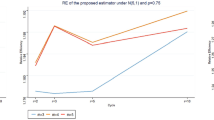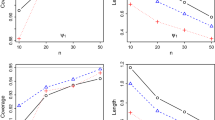Abstract
This article proposes an efficient class of estimators for population mean in ranked set sampling framework which includes the usual mean estimator, Upadhyaya et al. (1985) type estimator, Samawi and Muttlak (1996) estimator, Yu and Lam (1997) estimator, Khoshnevisan et al. (2007) type estimators, Bouza (2008) estimator, Koyuncu and Kadilar (2009) type estimators, Kadilar et al. (2009) estimator, Al-Omari et al. (2009) estimator, Singh et al. (2014) estimator, Mehta and Mandowara (2016) estimators, Mandowara and Mehta (2016) estimators and Bhushan and Kumar (2020a; b) estimators. The bias and mean square error of the proposed estimators are reported up to first order of approximation. It has been proven, both theoretically and empirically, that the proposed estimators provide more accurate results than the existing estimators.
Similar content being viewed by others
References
Al-Omari AI, Jemain AA, Ibrahim K (2009) New ratio estimators of the mean using simple random sampling and ranked set sampling methods. Revista Invest Oper 30(2):97–108
Bouza CN (2008) Ranked set sampling for the product estimator. Revista Invest Oper 29(3):201–206
Bhushan S, Kumar A (2020) On optimal classes estimators under ranked set sampling. Commun Statist Theory Methods. https://doi.org/10.1080/03610926.2020.1777431
Bhushan S, Kumar A (2020) Log type estimators of population mean under ranked set sampling. Predict Anal Using Statist Big Data Concepts Modell 28:47–74. https://doi.org/10.2174/9789811490491120010007
Bhushan S, Kumar A (2021) Novel log type class of estimators under ranked set sampling. Sankhya B. https://doi.org/10.1007/s13571-021-00265-y
Bhushan S, Kumar A, Lone SA (2021) On some novel classes of estimators under ranked set sampling. AEJ. https://doi.org/10.1016/j.aej.2021.11.001
Bhushan S, Kumar A, Singh S, Kumar S (2021) An improved class of estimators of population mean under simple random sampling. Philippine Statist 70(1):33–47
Dell TR, Clutter JL (1972) Ranked set sampling theory with order statistics background. Biometrics 28:545–555
Kadilar C, Cingi H (2003) Ratio estimators in stratified random sampling. Biomet J 45:218–225
Kadilar C, Unyazici Y, Cingi H (2009) Ratio estimator for the population mean using ranked set sampling. Stat Papers 50:301–309
Khoshnevisan M, Singh R, Chauhan P, Sawan N, Smarandache F (2007) A general family of estimators for estimating population mean using known value of some population parameter(s). Far East J Theoret Stat 22:181–191
Koyuncu N, Kadilar C (2009) Ratio and product estimator in stratified random sampling. J Statist Plann Inference 139:2552–2558
McIntyre GA (1952) A method of unbiased selective sampling using ranked set. Australian J Agric Res 3:385–390
Mehta N, Mandowara VL (2016) A modified ratio-cum-product estimator of finite population mean using ranked set sampling. Commun Statis Theor Methods 45(2):267–276
Mandowara VL, Mehta N (2016) On the improvement of product method of estimation in ranked set sampling. Chilean J Statist 7(1):43–53
Muttlak HA (1995) Parameter estimation in simple linear regression using ranked set sampling. Biomet J 37(7):799–810
Prasad B (1989) Some improved ratio type estimators of population mean and ratio in finite population sample surveys. Commun Stat Theory Methods 18:379–392
Samawi HM, Muttlak HA (1996) Estimation of ratio using ranked set sampling. Biomet J 38:753–764
Saini M, Kumar A (2016) Ratio estimators for the finite population mean under simple random sampling and ranked set sampling. Int J Syst Assur Eng Manag 8(2):488–492
Sarndal CE, Swensson B, Wretman J (2003) Model assisted survey sampling. Springer-Verlag, New York
Singh HP, Espejo MR (2003) On linear regression and ratio estimator using coefficient of variation of auxiliary variate. Statistician 52(1):59–67
Singh HP, Kakran MS (1993) A modified ratio estimator using known coefficient of kurtosis of auxiliary character. In: Singh S (ed) Advanced Sampling Theory with Applications, vol 2. Kluwer Academic Publishers, The Netherlands
Singh HP, Tailor R, Singh S (2014) General procedure for estimating the population mean using ranked set sampling. J Statist Comput Simul 84(5):931–945
Sisodia BVS, Dwivedi VK (1981) A modified ratio estimator using coefficient of variation of auxiliary variable. J Indian Soc Agric Stat 33:13–18
Singh HP, Horn S (1998) An alternative estimator for multi-character surveys. Metrika 48:99–107
Takahasi K, Wakimoto K (1968) On unbiased estimates of the population mean based on the sample stratified by means of ordering. Annal Instit Statist Math 20:1–31
Upadhyaya LN, Singh HP, Vos JWE (1985) On the estimations of population means and ratios using supplementary information. Statist Neerlandica 39(3):309–318
Upadhyaya LN, Singh HP (1999) Use of transformed auxiliary variable in estimating the finite population mean. Biomet J 41:627–636
Yu LH, Lam K (1997) Regression estimator in ranked set sampling. Biometrics 53:1070–1080
Author information
Authors and Affiliations
Additional information
Publisher's Note
Springer Nature remains neutral with regard to jurisdictional claims in published maps and institutional affiliations.
Appendix A
Appendix A
The MSE of the existing estimators is given below.
The optimum values of constants involved in the estimators can be obtained by minimizing with respect to the constants as
where \(K_i={{\bar{Y}}}/{({\bar{X}}+q_i)},~i=1,3\), \(A_s=1+\Delta _{2,0}\), \(B_s=1+\Delta _{2,0}+g(2g+1)\theta ^2\alpha ^2\Delta _{0,2}-4g\theta \alpha \Delta _{1,1}\), \(C_s=1+\Delta _{2,0}-2g\theta \alpha \Delta _{1,1}+\{{g(g+1)}/{2}\}\theta ^2\alpha ^2\Delta _{0,2}\), \(D_s=1+\{{g(g+1)}/{2}\}\theta ^2\alpha ^2\Delta _{0,2}-g\theta \alpha \Delta _{1,1}\), \(I_i={({\bar{X}}+q_i)}/{(2{\bar{X}}+q_i)^2},~i=1,3\), \(\delta _1={\bar{X }}/{({\bar{X}}+C_x)},~ \delta _2={{\bar{X}}}/{(\bar{X }+\beta _{2}(x))}\), \(\delta _3=\delta _4=t_3={{\bar{X}}C_x}/{(\bar{X }C_x+\beta _{2}(x))}\), \(P_i=1+\Delta _{0,2}-{\Delta _{1,1}^2}/{\Delta _{2,0}},~i=1,3\), \(Q_i=1,~i=1,3\), \(P_2=1+\Delta _{0,2}+\nu \Delta _{1,1}-{2\Delta _{1,1}^2}/{\Delta _{2,0}}\), \(Q_2=1+{\nu \Delta _{1,1}}/{2}-{\Delta _{1,1}^2}/{2\Delta _{2,0}}\).
Rights and permissions
About this article
Cite this article
Bhushan, S., Kumar, A. An efficient class of estimators based on ranked set sampling. Life Cycle Reliab Saf Eng 11, 39–48 (2022). https://doi.org/10.1007/s41872-021-00183-y
Received:
Accepted:
Published:
Issue Date:
DOI: https://doi.org/10.1007/s41872-021-00183-y




